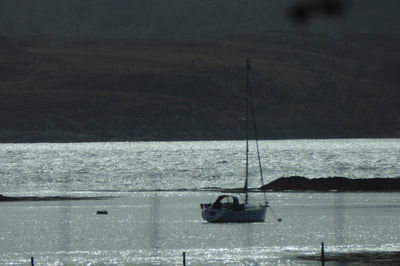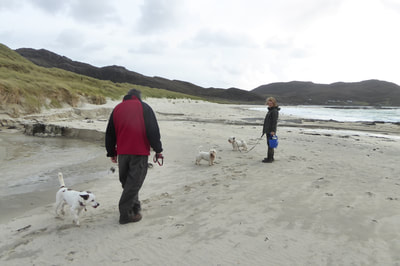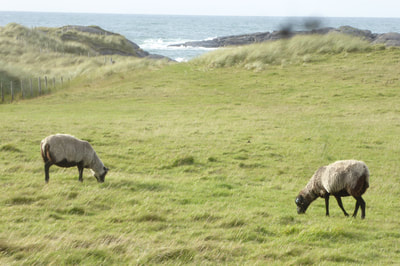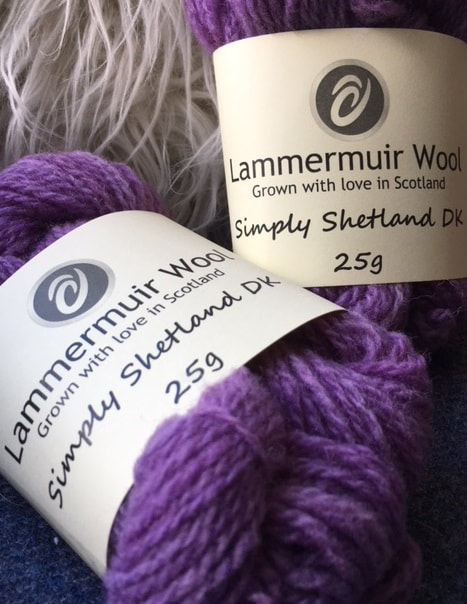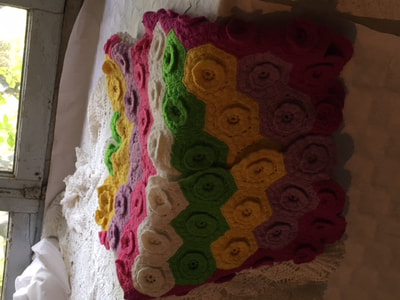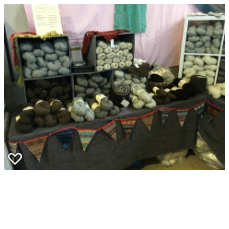|
The sheep now produce a great range of wool ....I like to check out yarn shops, yarn producers and sheep.
The weeks away mostly consisted of wrapping up warm and dragging Hamish out on bracing walks along beaches and up glen paths but whilst staying in Kinlochmoidart recently (and hiding from Storm Ali) I was able to visit a flock of Shetlands with which we have a long-standing relationship. Over the years, we have swapped ewes and tups and supported each other in finding a way forward through the world of wool. The sheep are based at Sanna, on Ardnamurchan and - we managed to combine a visit to the lighthouse which we hadn't visited since about 2004 with an afternoon's sheep-talk. The terrain is so different from that of East Lothian and the Borders, but the sheep that we have sold on to live here have adapted well and show what great value Shetland sheep are to the small holder and crafter where terrain and conditions can be harsh. The sheep produce a beautifully soft range of wool for West Highland Woollery - check them out on facebook. The approach of autumn always has me in a frenzy of activity - perhaps it'a a hangover from old lives where September meant the start of the school or university year. This autumn we did our first ever Perth Festival of Yarn and I have to say, we were a bit nervous. In thinking about how best to showcase our wool at this event I decided on two things: - hat bunting (to illustrate our undyed and dyed shades working together) - creating some new shades of dyed wool The hat bunting was fun to do - although my hands suffered for it. My aim was ten brightly coloured hats but in the end I could only get eight done. And a swift web-based lesson in knitting iCord helped me to display them properly. I had always been unsure that people would want to 'buy what they can see' but the display certainly helped to spark people's thinking.In picking two new dyed shades, in the end I went for Bramble and Bracken, with the bramble shown below. When not working (or , dyeing wool or knitting hats, I have mainly been bramble and sloe picking ... Over all, Perth FoY was an incredible event for us: really helpful event team and lots of space so that the venue never felt crushed or crowded. Financially it was very successful and has re-booted our enthusiasm for woolly events. Big thanks to Eva and team! When I'm at woolly events, I always find myself thinking about the value of things which are have traditionally been classed as 'women's work'. Several encounters this summer have brought this closer to home. We spent a good chunk of Italy in Barga, in the north of Tuscany. Not the Tuscany of a million postcardss: the chianti-shire rolling hills and olive groves with roads flanked by rows of dark cypress trees, but instead a mountainous landscape cloaked in chestnut and pines, where the traditional foods are wild funghi, castagne, mirtilli, lepre and cinghiale. Barga badges itself as 'the most Scottish town in Italy, and is home to a fish and chip festival each summer. My in-laws - particularly my late mother-in-law, Bianca, and sisters-in-law, Anna and Letizia and cousin-in-law Roberta are skilled in a number of textile-based crafts. I will never forget getting my hands slapped by Bianca before I was patiently shown how to both crochet and knit 'the right way' I think that Italians always have 'the right way' to do things. And they are, generally, right. I spotted a leaflet for an exhibition subtitled 'Lavori di donne antiche e moderne in mostra' and persuaded Anna to come along with me for essential translation purposes - and also because I knew that she would be able to explain exactly what I was looking at: Many of the items that I saw looked familiar. So Italian. We have a cottage full of bits and pieces of trimmings, wee cloths and so on all in this similar starched white fresh Italian white cotton or linen. Picked up at markets... It has just become part of how we live.
A lot of the pieces were designed for 'bottom drawers' and for special gifts. Some of the items on show were made on a massive scale in tiny stitches - lovingly crafted by women working Without Electric Light. My eyes hurt just thinking about it. And every time I asked a question - and people who know me will testify that I ask a LOT of questions - there was a women on hand to show me exactly how things had been made and stitched. Threading needles and showing me how to do it; explaining the Italian name for each technique. The curator of the exhibition was a Australian Italian. and was passionate about two things: preserving and highlighting this highly skilled work; and trying to encourage a new generation. Young women who might want to learn these skills. There were local workshops and 'new hands' were able to learn from older ones. A living tradition as it should be. Such a rich heritage to risk losing it. 2018 was our first visit as stallholders at Woolfest. I have visited a few times in the past; as a customer and also as a helper on the Shetland Sheep Society stand. I have always come away awestruck by just how creative and entrepreneurial so many people are, and inspired to do more myself. Applying to 'do' Woolfest was a big decision: it is a multi-day undertaking requiring accommodation and paid-for doggy-care, as well as travel costs and stall fees. We were encouraged to apply for a mini-stall; an initiative run by Woolfest to encourage new and smaller sellers. I worked hard on the application and was both excited and scared to find out that I had gained a place at this year's event. Despite still being short of stock (because my missing 16kg of spun wool is still mislaid by Parcelforce), I worked hard in the weeks leading up to the event: weighing, re-skeining; dyeing; drying; labelling .... We set up on the Thursday afternoon and were finished quite quickly which meant we could help out our neighbouring stall-holders. Especially Paolo, as he has Long Arms Which Can Reach Things. Our stall didn't look too bad and - as we were in a bit of a dark corner - we felt we had lightened it up as best we could. We'd booked a farm cottage about 30 minutes stunning drive away, which was blissfully quiet. The Festival is open Friday and Saturday, and it was great to meet people who were interested in the wool and its provenance. People had questions (some challenging ones!) about sheep-farming practice and we were able to bust some myths. The quality of the wool speaks for itself and people - some of whom expect Shetland wool to be 'scratchy' were pleasantly surprised at how soft it is. The dyed wool went down well and people seemed able to imagine how they could work the greys, moorits, natural whites and dyed shades together. The names of the shades, and the inspiration behind them was also a great talking point. It was exhausting and the days seemed very long - something to do with standing on concrete, I think! It was an enjoyable event for us - we got to meet new customers (and old ones), as well as some useful conversations with other stall holders and designers. I managed to avoid buying much wool (just some John Arbon Devonia for another shawl, and some Blane Norwegian wool to finish a sweater I'm working on. But I did buy a wee hook-rug kit in the shape of a fish. It's now finished and I love it! On the Sunday, we ventured to the Woolclip's shop in Caldbeck which is definitely worth a visit.
We took this photo of a neighbouring field last month - when everything was still very fresh and green. It does not look the same now! The lambs - which were so tiny back in April have really grown, with some of the larger lambs now almost as big as their mothers. To watch two huge lambs diving for their mother's milk with such strength that they lift the ewes back-end off of the ground is funny to see, but the ewes are starting to look a bit fed up of the whole business of providing milk to such boisterous and independent off-spring. We will probably wean off the lambs in late August, moving the ewes a few miles away to a different field, where they have nothing to do but eat and regain condition. We lost two lambs over the last few months - and each occasion was very sad. One lamb developed CCN - a brain illness - and the other who we nursed carefully for over a month - never really recovered from being abandoned by her mother (and stolen by another ewe) at birth. Both times we were able to take the lambs to our local vet to have them euthanised. It's very upsetting for us as we spend a lot of time with our sheep (and even more with the ill ones!) and grow attached to them. We had to bottle feed two lambs for the first momth or so after they were born. The ewe birthed twins but would only ever feed one. If the second lamb tried to feed she would butt it away. However, she did not reject the lamb outright (as sometimes happens). It turned out that the ewe really only just had enough milk for one lamb and so had made a decision not to feed the second. There's a wee film clip below showing the paler lamb (the one not being fed by mum) looking a lot quieter and less active than her sister. We kept the three of them in a pen for over a week so that mum got used to the idea of both lambs being around. We ended up feeding both of them and the ewe later came to allow both lambs to nurse for what milk there was. Four feeds a day become three, then two, then one and now both lambs are fully independent. Having been bottle-fed, they are irrepressible, and the first to run up when we arrive at the field each day. The lambs are currently called Tillie and TillieToo but we will have to find proper names, soon. Here is TillieToo getting stuck in to the bottle... It was a tricky lambing period over all with some new challenges for us but lambs now seem healthy, happy and are growing fast.
After several months of anxious waiting my last batch of wool from the 2017 clip has arrived. I am still short of some but will have enough (fingers crossed) for the remaining shows this year.
The wool above is a lovely soft blend of our Shetland first-clip and some Romney fleece. It makes a beautifully airy wool with lots of 'bounce' in it. And I have started knitting with it already .... .I'm using it with some dyed Lammerloch blue to make yet another Surge shawl. I got another lovely box full of my Simply Shetland Single - laceweight wool, and a batch of pale grey DK which we have christened Haar - named after the North Sea mist which sometimes rolls inland at this time of year - sometimes cloaking us in fog for days. All of these new items are now in the Store of this website and will be available at Woolfest in a few weeks time. Now we are just dyeing wool, waiting on wool bands to come back from the printer, and thinking about shearing the 2018 clip. More on that next time. Lambing was tough this year and threw up a number of challenges that we hadn't faced for a long time. I like to think it was partly down to the odd weather we've had over the last few months. Still, we've made it with only a very small number of losses and one caddy lamb who is slowly being weaned off the bottle. The two lambs pictured above have also given us some headaches. The mother - Alice - had a single white (shown) and also stole the grey katmoget ewe lamb from Birgitta (who had also had a GIANT grey katmoget tup immediately named Brian Boru). Wee adoptee probably didn't get enough colostrum before we got to the field and has been on increasingly strong antibiotics over the last couple of weeks for fluid-filled lungs and poorly legs. As the vet says - the prognosis isn't great - but we are doing what we can.
First lamb of this year was Breck (or breac) meaning speckled or spotted. He was huge when born and is even bigger now! I love St Abbs Wool Festival - I love everything about it and enjoy being a vendor here. Despite being a bit shy, I can talk about sheep and wool for Scotland, and anyway I love hearing about what other people have knitted. I was a bit short on wool to take, as I’m still waiting on a missing 16kg of spun grey wool courtesy of Parcel Force who now think they might have delivered it to someone else by mistake. However, I labelled everything I had, dyed lots more wool taking into account the feedback I got in Edinburgh, and I was quite pleased with my display! I was also placed opposite my absolute favourite stall at the event; Pink Minis who designs and makes the most awesome tweed clothes. Trade was great! I was very happy that people had come back after buying yarn from me at St Abbs previous festivals; including people who bought sweater-quantities of yarn, as well as people who had been at EYFs Meet the Shepherdess event a few weeks before. I took along a good selection of dyed mini-skeins and was pleased with how they came out! As usual, I spent a lot of time just chatting with people about their own knitting and certainly fell in love with this shawl worn by one customer! The pattern is Surge by Lisa Mutch on Ravelry and I was inspired by the combination of colours and the short rows used. It’s knitted in 4 ply and I just might have some Devonia 4 ply by John Arbon in my stash which would be ideal for this! I also plan to dye some of my white 4 ply when it arrives from the Mill. I really did have to sprint off at the other end to head back to the lambing field, but once again a massive thanks to Jennie from SkyBluePink Designs for all the hard work she does in organising this event. It is a real success!
|
Archives
January 2024
Categories |
Proudly powered by Weebly

